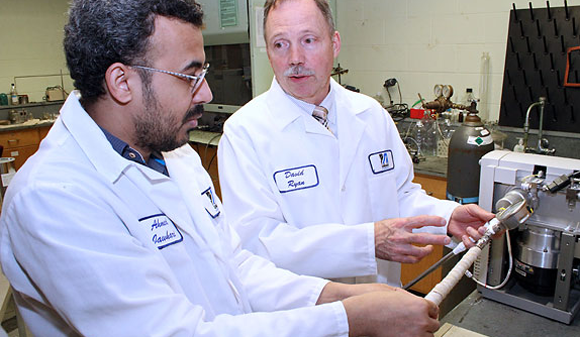Scientists develop method to power electric vehicles using water, CO2 and cobalt
April 9, 2019

Prof David Ryan (right) and graduate student Ahmed Jawhari (left) examine a prototype of their invention, which produces hydrogen gas using water, CO2 and cobalt to power electric vehicles (Courtesy University of Massachusetts Lowell)
Researchers at the University of Massachusetts Lowell, USA, report that they have developed a new way to power electric vehicles by using water, carbon dioxide and cobalt to produce hydrogen gas on-demand at low temperature and pressure. The research team is led by Prof David Ryan, Chemistry Department Chairman, and believes that its new technology could enable vehicles of all sizes to run for longer while maintaining zero emissions.
Because the majority of electric vehicles currently in use are powered by batteries which must be recharged periodically, and which have limitations such as storage capacity, the time required to recharge, and cost, much current electric vehicle technology is only practical for small cars and not for larger vehicles such as trucks and busses. Prof Ryan, however, believes that the technology developed by his team could be used to power vehicles of all sizes.
In an electric vehicle using this technology, all hydrogen created would go directly into a fuel cell, where it would be mixed with oxygen from the atmosphere to generate electricity and water. The generated electricity would then power the system that operates the vehicle’s motor, rechargeable battery and headlights.
“This process doesn’t store any hydrogen gas, so it’s safe and poses no transportation issues, greatly minimising the possibility of a fire or explosion,” commented Prof Ryan, adding that the hydrogen generated by the technology is more than 95% pure. “Hydrogen burns completely clean; it produces no carbon dioxide, only water. And, you don’t have to burn hydrogen to generate electricity. Hydrogen can be used in fuel cells, in which it combines with oxygen from the air to produce electricity at up to 85% efficiency.”
Further, “since hydrogen is not mined or pumped out the ground like fossil fuels, we have to produce it,” he added. “Current methods of doing that are expensive and inefficient. This, coupled with the lack of needed infrastructure, has hampered the transition from a petroleum to a hydrogen economy. Our hope is that the catalytic hydrogen technology we have developed would help solve all of these challenges.”
Prof Ryan’s team includes Ahmed Jawhari, Kehley Davies, and Elizabeth Farrell, PhD candidates in Chemistry; and Colleen Ahern, an undergraduate Chemical Engineering major. The researchers have been awarded a provisional patent and are awaiting a full patent on the technology. In addition to support from the University of Massachusetts Lowell, the Massachusetts Clean Energy Center has reportedly provided the team with $25,000 in seed funding to help commercialise the technology.















